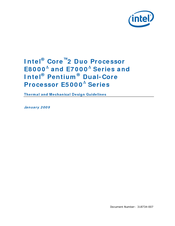INTEL CORE 2 DUO E7000 - UPDATE 7-2010 Manuals
Manuals and User Guides for INTEL CORE 2 DUO E7000 - UPDATE 7-2010. We have 5 INTEL CORE 2 DUO E7000 - UPDATE 7-2010 manuals available for free PDF download: Manuallines, Design Manual, Datasheet, Specification, Product Brief
INTEL CORE 2 DUO E7000 - UPDATE 7-2010 Design Manual (126 pages)
Thermal and Mechanical Design Guidelines
Brand: INTEL
|
Category: Computer Hardware
|
Size: 3 MB
Table of Contents
Advertisement
Intel CORE 2 DUO E7000 - UPDATE 7-2010 Manuallines (128 pages)
Thermal and Mechanical Design Guidelines
Brand: Intel
|
Category: Computer Hardware
|
Size: 3 MB
Table of Contents
Intel CORE 2 DUO E7000 - UPDATE 7-2010 Datasheet (102 pages)
Data Sheet
Brand: Intel
|
Category: Computer Hardware
|
Size: 1 MB
Table of Contents
Advertisement
INTEL CORE 2 DUO E7000 - UPDATE 7-2010 Specification (50 pages)
Brand: INTEL
|
Category: Computer Hardware
|
Size: 0 MB
Table of Contents
Intel CORE 2 DUO E7000 - UPDATE 7-2010 Product Brief (2 pages)
Intel Core2 Duo Desktop processors Product Brief
Brand: Intel
|
Category: Computer Hardware
|
Size: 0 MB
Table of Contents
Advertisement




